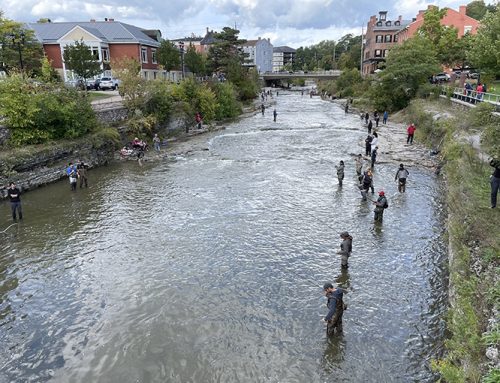
A unique study by researchers at the University of Toronto (U of T) released in March contained startling results about the environmental impact of road salt.
The topic has been the subject of growing concern and increasing amounts of research, but most studies on the influence of chloride in aquatic ecosystems have focused on the winter months when salting actually occurs.
The U of T authors, however, tested summertime concentrations and effects of residual chloride in four southern Ontario waterways: the Humber River, the Don River, Mimico creek, and Etobicoke creek, in July and August.
It is well-documented that road salt is linked to a host of ecological issues, from roadside tree mortality to increased aquatic algal blooms. Typically, it makes its way into our lakes and rivers via runoff and can be stored year-round in the soil and groundwater.
So, the authors used the federal government’s guideline for acute and chronic exposure to chloride, which outlines average concentrations required to significantly affect a variety of aquatic organisms, to gauge the significance of their findings.
Results
The results were startling: 89% of sample sites contained concentrations of chloride that exceeded federal chronic exposure guidelines, while 13% exceeded federal acute exposure guidelines.
The highest average levels were found throughout Mimico creek. These findings are significant because chloride levels are expected to be at their lowest during summer. Worse still, summertime is an important period in the development and reproductive cycles of many aquatic organisms. Countless fish and invertebrates are in their earliest post-hatch life stages during the months of July and August, making them especially vulnerable to the influence of chemicals. Salmonids like rainbow trout, for instance, can be extremely sensitive to increased levels of chloride during early development and, in summer, these fish already have to contend with the stress of warmer water temperatures and potential reductions in dissolved oxygen.
Ultimately, the authors conclude that 34% of their study sites contained chloride levels high enough to affect one quarter of the species present.
They also add that, according to previous research, some aquatic species can be affected by chloride concentrations that are below the federal guidelines, potentially rendering the conclusions of this study overly optimistic.






As beïng a Dutch inhabitant it is good to see that Ontario Out of Doors uses a photografe of a Dutch car salting a road in a Dutch village. Thank You!!
Just wonder why you use such light print in the emailed version of your articles? Makes them difficult to read…
Good Morning, Lloyd,
You mean in our monthly newsletters? It may be an email or hardware formatting issue. Do you find our text content on the website light as well?
If levels are that high in southern Ontario where it hardly ever snows. They must be way higher in the north where the road is salted several times per week for over 6 months.
Many years agricultural which due to high cost puts on the right amount and no more and with applications restrictions yet they get ALL the blame. Now it’s public we’re the pressure is about algae blooms. I have suspected this for years
I have argued for years that the many tons of road salt is not only bad for vehicles but it eventually gets washed into the lakes and rivers. I am not just talking about a little bit of salt but thousands of tons used on the roadways. I lived in Edmonton a few years where they dont use salt and only gravel the intersections.It took a while but one can get used to no salt on the roads and drive more carefully and slow down in the winter months. Ontario drivers are spoiled in the excessive use of road salt. They need to be educated and just leave ten minutes earlier to get to work that is all that is necessary.
We definitely need to look at the elimination of salt used on our sidewalks and roadways. Issues with road salt have been known for years and very little has been done to curb its use.
Ontario should mandate winter tires on all vehicles and use only sand on winter roads as needed.
I’m aware that some regions and municipalities have adopted the practice of putting beat juice on roadways to reduce the slipperiness caused by cold weather conditions, snow or ice. Is this a viable solution and how does beat juice runoff affect our roadside foliage, waterways and the aquatic organisms that reside in them?
Thank you, Paul. A good question that OOD is not in a position to answer. There have been pilot projects in some Canadian cities, according to reports from the CBC. https://www.cbc.ca/news/canada/calgary/calgary-beet-brine-snow-ice-control-1.4909615